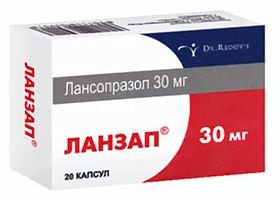
All iLive content is medically reviewed or fact checked to ensure as much factual accuracy as possible.
We have strict sourcing guidelines and only link to reputable media sites, academic research institutions and, whenever possible, medically peer reviewed studies. Note that the numbers in parentheses ([1], [2], etc.) are clickable links to these studies.
If you feel that any of our content is inaccurate, out-of-date, or otherwise questionable, please select it and press Ctrl + Enter.
Lanzap
Medical expert of the article
Last reviewed: 03.07.2025

ATC classification
Active ingredients
Pharmacological group
Pharmachologic effect
Release form
Available in capsules of 10 pieces on 1 blister. The pack contains 2 blister plates.
Pharmacodynamics
Lanzap is classified as an antisecretory, antiulcer drug. It inhibits the activity of H + K + ATPase inside the parietal cells of the gastric mucosa. This allows the drug to suppress the final stage of acid formation in gastric juice and at the same time reduce its amount and acidity level. This reduces the negative effect of gastric juice on the mucosa. The strength of suppression depends on the dosage and the duration of the therapeutic course. A single dose of 30 mg allows you to suppress the production of hydrochloric acid by 80-97%.
Pharmacokinetics
Lansoprazole is a labile acid contained in the drug in granules with an intestinally soluble surface. The substance is rapidly absorbed in the intestine. Peak plasma levels are 0.75-1.15 mg/l and are reached in 1.5-2.2 hours.
The drug is excreted with urine and bile. The half-life is 1.5 hours. This indicator may increase in people suffering from severe liver dysfunction, as well as in the elderly. In case of renal failure, there are almost no changes in the absorption rates of lansoprazole. It is synthesized with plasma protein by 98%.
Dosing and administration
The capsules should be taken whole, without chewing or crushing. Wash down with water. Take usually once a day – in the morning or in the evening (in both cases before meals).
For duodenal ulcers, it is necessary to take 30 mg twice a day for a period of 2-4 weeks.
For stomach ulcers, take 30 mg twice a day for 2-8 weeks.
For GERD, 30 mg of the drug is taken twice a day for 1-2 months. After this period, maintenance treatment begins: taking 30 mg per day for up to 1 year.
For gastrinoma, the initial dosage is 30 mg three times a day. The dose is then adjusted based on the basal acid secretion in the stomach:
- less than 10 mEq/hour for people who do not have a history of gastric surgery;
- less than 5 mEq/hour in people who underwent such interventions.
Daily doses within 120-180 mg should be administered twice a day (morning and evening).
The destruction of Helicobacter pylori bacteria can be carried out according to the schemes indicated below.
"Triple" treatment:
- a dose of 30 mg twice a day, in combination with metronidazole at a rate of 500 mg twice a day (or with tinidazole, also 500 mg) and clarithromycin: 500 mg twice a day;
- dosage of 30 mg twice daily in combination with twice daily intake of 500 mg clarithromycin, as well as twice daily intake of 1000 mg amoxicillin.
"Quadro" treatment, which helps to achieve results in people who have not been helped by the "triple" treatment scheme:
- 30 mg twice daily in combination with bismuth medications (e.g. bismuth subcitrate): 120 mg four times daily (dosage calculated as bismuth oxide). Also with tetracycline: 500 mg four times daily and metronidazole: 500 mg three times daily (or tinidazole, 500 mg three times daily).
 [ 5 ]
[ 5 ]
Use Lanzapa during pregnancy
It should not be prescribed to pregnant women. Breastfeeding should be discontinued during treatment.
Contraindications
Contraindications include: intolerance to the components of the drug, as well as childhood.
Side effects Lanzapa
In general, the drug is well tolerated, but in case of prolonged use, side effects may develop:
- digestive system: abdominal pain, diarrhea and nausea, occasionally constipation develops;
- nervous system organs: headaches, in rare cases fatigue, drowsiness and dizziness may occur;
- skin manifestations: rash, erythema multiforme, and urticaria;
- Others: dryness of the oral mucosa occasionally develops.
Interactions with other drugs
Since the drug is metabolized in the liver using the P450 hemoprotein system, caution should be exercised when combined with phenytoin, prednisolone and diazepam, as well as theophylline, propranolol and warfarin (Lanzap can reduce the elimination of these drugs, which requires a reduction in their dosages).
Antacid medications containing magnesium and aluminum hydroxide may be taken at least 2 hours after taking Lanzap.
 [ 6 ]
[ 6 ]
Storage conditions
The medicine should be kept in a place out of reach of children, as well as away from the sun and moisture. The temperature indicator is a maximum of 25°C.
 [ 7 ]
[ 7 ]
Shelf life
Lanzap is approved for use for 2 years from the date of release of the drug.
Manufacturer
Attention!
To simplify the perception of information, this instruction for use of the drug "Lanzap" translated and presented in a special form on the basis of the official instructions for medical use of the drug. Before use read the annotation that came directly to medicines.
Description provided for informational purposes and is not a guide to self-healing. The need for this drug, the purpose of the treatment regimen, methods and dose of the drug is determined solely by the attending physician. Self-medication is dangerous for your health.

